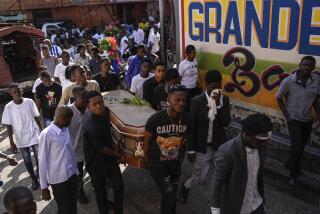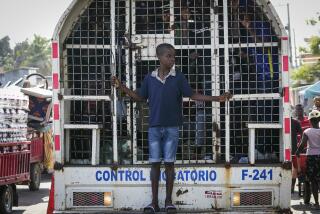Concert to Ease Dominican-Haitian Tensions Ends on Troubled Note
DAJABON, Dominican Republic — As the sun set orange on the Massacre River, at the site of a 1937 ethnic cleansing, the Dominican band struck up a belated serenade to peace.
Across the rain-choked border creek that Sunday in October, hundreds of Haitians strained to hear and see the Dominicans, their rivals for centuries, on the other bank.
It was a poignant moment in the tortured and tangled relationship between the two countries that share the Caribbean island of Hispaniola. But like many a worthy cause, it fell victim to politics and the weather.
The night before the concert, the stage constructed in the middle of the river was washed away by rain --so the performance had to be held on the Dominican Republic side.
And what Dominican officials hoped would be a joint endeavor with the Haitian symphony orchestra turned into a solo performance when Haitian officials declined to send their musicians and Haitian President Rene Preval stayed away without explanation. His Dominican counterpart, Hipolito Mejia, showed up but left before the concert.
“This is a song to peace,” Giovany Cruz, the Dominican undersecretary for culture, told a reporter. “This is the river that they crossed to invade us. This is the river we crossed to kill them. And it’s here that we must meet.”
Historical accounts say the Massacre River got its name in 1728 after Spanish colonists slaughtered a band of French pirates. It was by no means the last massacre on the island. In 1937, Dominican dictator Rafael Trujillo ordered his country cleansed of Haitians. Estimates of the dead range from 12,000 to 34,000.
Relations between the countries have always been tense, punctuated by invasions and massacres that often revolve around race.
Though the 9 million Dominicans and 8 million Haitians share African ancestry and a history of slavery, the mainly brown-skinned Dominicans ruled by the Spanish distrust their darker and poorer neighbors. Haitians were ruled by the French until they staged the world’s only successful slave rebellion to become independent in 1804.
Trujillo was a well-known racist. He would wear pancake makeup to hide the fact that his grandmother was Haitian, and periodically tried to recruit single European immigrants to “whiten” his country’s gene pool. The week before the 1937 massacre, Trujillo visited the border town of Dajabon and is said to have been astonished by how many dark people were there.
Some say racism wasn’t the only factor. In the middle of a deep recession, Dominicans feared competition from Haiti and from Haitians in their country; the slaughter may have helped Trujillo defuse tension at home.
Dominicans are a society still traumatized by Haitian occupations of the early 19th century. They mark their independence in 1844 for the day a 22-year Haitian occupation ended. Juan Pablo Duarte, a leader of the anti-Haitian resistance, is a national hero.
The two countries have harbored each other’s ousted dictators and have even involved themselves in plots to topple each other’s governments.
There is still little cooperation. Mail has to go through Miami, and only in the last year or so did a regular thrice-weekly air service begin between the two capitals. Two weeks ago, the Dominicans refused to return seven Haitian police officers who fled across the Massacre River after being accused of plotting to overthrow Preval.
Many Dominicans say they are facing another invasion, this time by laborers unable to find work in their more impoverished homeland.
“We are a poor country,” said Altagracia Garcia, a housewife in the capital, Santo Domingo. “We have to send them back to their country, otherwise we will become another Haiti.”
So Dominican authorities continue to mount politically popular mass deportations of desperate Haitians, ignoring human rights groups’ complaints and their own need for Haitians to do lowly paid jobs that Dominicans spurn. Haitians cut the cane in conditions not far removed from slave labor, and form the backbone of the construction industry that has been pivotal in the Dominican Republic’s recent economic boom.
The deportations often take on a racial tone, with Dominican soldiers rounding up the darkest-skinned people they can find--and occasionally sending a dark-skinned Dominican over the border by mistake.
In June, the army killed six Haitians and a Dominican who were said to have crossed the border illegally and run a roadblock. The event drew little scrutiny here.
The Haitian government has offered no explanation for its non-appearance at the concert, and the Haitian media never announced it in advance.
Still, the turnout among Haitians living along the border was impressive. They stood up to 10 deep in the narrow space between the water and a banana field, applauding their national anthem and the Dominican one that followed.
Then master of ceremonies Yaqui Nunez announced “a hymn that unites us in this moment:”
And the symphony orchestra played Beethoven’s “Ode to Joy.”
More to Read
Sign up for Essential California
The most important California stories and recommendations in your inbox every morning.
You may occasionally receive promotional content from the Los Angeles Times.










